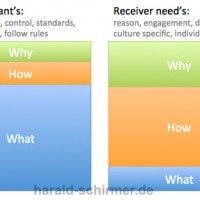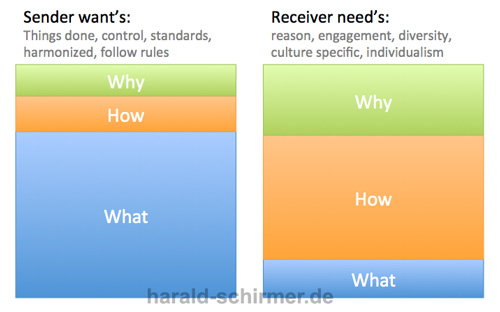
Yesterday in our Enterprise 2.0 Meetup in Stuttgart (here are some tweets about it), I presented my interpretation of the „Sender-Receiver“ Problem, which I often see in Business Situations and Leadership. The following model is based on the experience I made with the GUIDE Concept to introduce Social Business in a global company.
In the past I realized that the leader, project teams or authorities, which tried to change something in people, faced sometimes just little effect. Analyzing what „they“ wer thinking about (and focusing on) – giving tasks or trainings to others on one side and listening carefully about the questions the people had (and their reactions) on the other – showed me a big gap.
In the GUIDE concept I was trying to build the virtual team of the GUIDEs on a Vision (we built together) and „TRUST“ and giving people freedom to act (or I would call it „offering chances„), we could reach great, divers and fascinating results.
If we see every task or action – as a CHANGE for the potential target group, we might realize, that we need to think of the impact in a different way:
There are important authors like Paul Watzlawik, the Shannon-Weaver Model, or Schulz von Thun, discribing this already – maybe I can add a little to it from my practical point of view:

On Sender Side:
- The „Why we do it“ is not really questioned or communicated, since it often is „just our job or task“
- The „How it should be done“ also finds minor priority – for many reasons:
- missing competence in user friendly workflows (mostly describing things from top view, but receiver is IN the process – just needs to see what is before and after)
- missing resources for translation into the needed languages – „company language“ seems to be so easy to agree on
- cultural testing and adaptation – each culture has different ways to deal with the same task
- finally the usability is the part, still seen as „nice to have“ – function is there…
- Main Focus is on the „What should be done“
- that is in focus of the trainings
- the concept is built around being able to control and measure status and results ( KPI – Key Performance Indicators )
- Harmonization and Standards are important to handle complex topics – making it easier to put on a „board presentation – one pager
- Rules help ensuring quality and following the right process
On Receivers Side:
- WHY: Before anyone starts something – he/she desperately wants to know AND UNDERSTAND why it should be done
- In the GUIDE concept I put quite some effort in discussing and clarifying all the questions around (building a vision)
- Why should WE do it?
- Why should IT be done at all?
- Why NOW?
- Why with this setup?
- Building a vision TOGETHER builds long lasting engagement – even against massive resistance (Many GUIDEs even want to continue, in case the „official“ program would be stopped)
- In the GUIDE concept I put quite some effort in discussing and clarifying all the questions around (building a vision)
- HOW: A major question everyone want’s to know next: „Give me a hand, help me, show me…“
- Having pilot groups, who have real influence on the how – makes them great supporters
- The „Sender“ must walk the talk and DO his/her/it’s own processes first – to experience, what it takes to do the „what“ … usually that would solve already many issues 😉
- user-friendly and good-looking Templates, GUIDEs, Workshops are important
- „self-explaining“ must be a given feedback from the users – not as a message from the sender (else it just results in: „If you don’t get it – you are dumb!“… which usually is not really engaging)
- WHAT: … well this is for the receiver not the biggest question, because this is what he/she is getting paid for (so the opposite as for the sender)
One great inspiration for the graphical model was a TED video of Simon Sinek:
What Do you think about this – do you have something to add?

Schreibe einen Kommentar